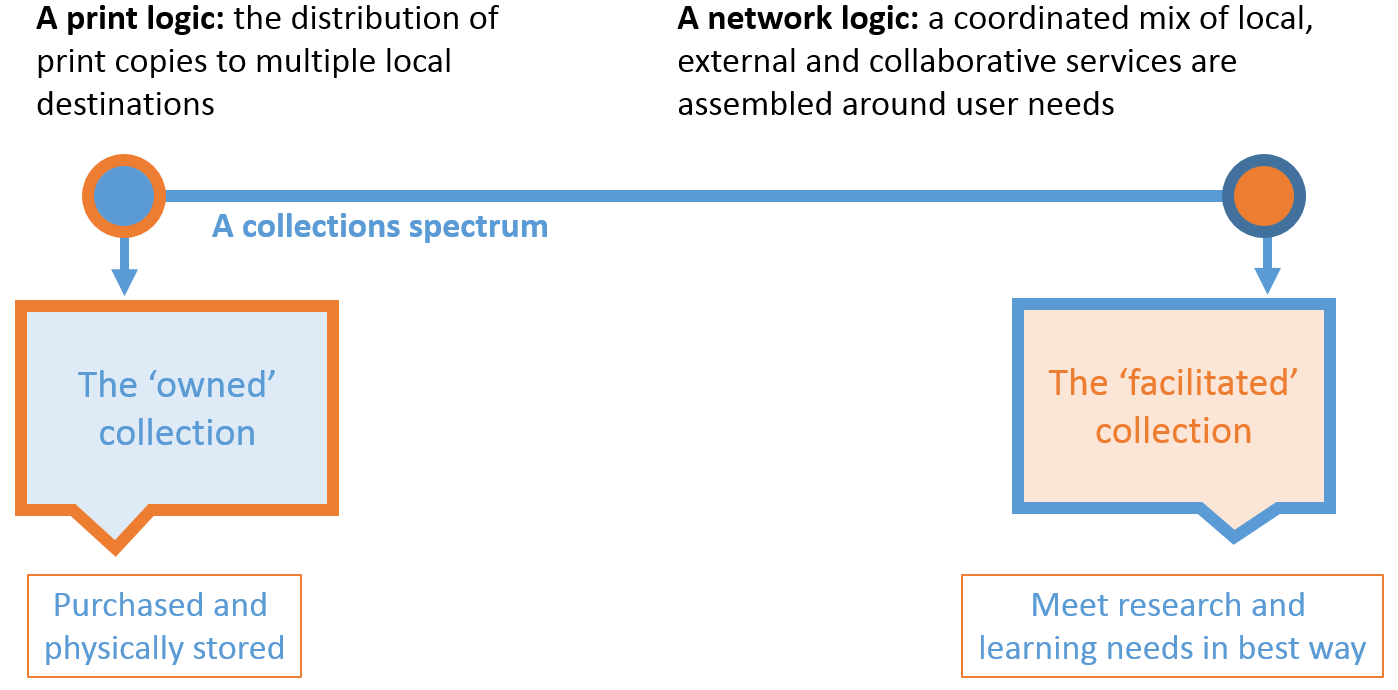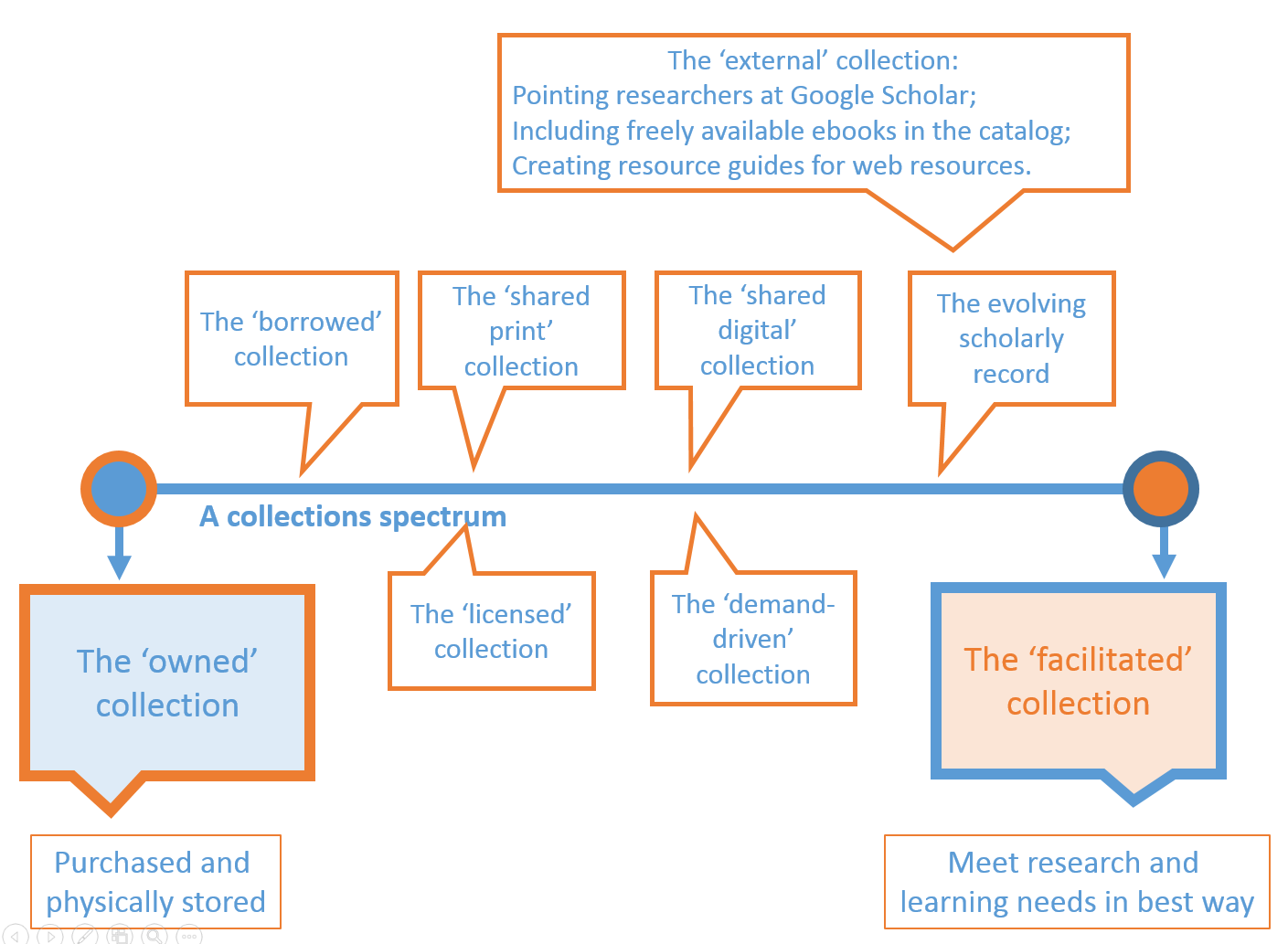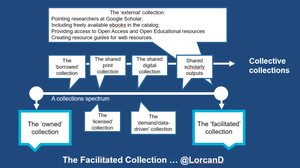Collections have been central to library identity – we have discussed how library collections are changing in a network environment elsewhere (Collection Directions: The Evolution of Library Collections and Collecting – PDF). Support for the discovery, curation and creation of resources in research and learning practices continues to evolve. In this blog entry I discuss one element of these changes, the emergence of what I call the facilitated collection, a coordinated mix of local, external and collaborative services assembled around user needs
Collections and a print logic
Library collections were strongly shaped by a print logic. This required the distribution of print copies to multiple local destinations. In this way, materials could be closer to the user, to allow immediate access. This had two consequences. First, collections were assembled on a ‘just in case’ basis. And, second, the size of the collection was strongly associated with the goodness of the collection. The larger the local collection, the more potential local requirements could be met. The library collection was an owned collection. Of course, the library collection is no longer entirely owned (think of the importance of licensed collections, for example) but this was an important shaping influence on our collections and still influences our thinking about them. And, certainly, the size of a locally owned collection is still important in popular perceptions of ‘goodness’. Just look at library job adverts or university promotional materials for potential students where it is common to mention collection size.
The facilitated collection is organized according to a network logic
The network environment is very different in several important ways. These are well-known, but it is useful to list some.
- The need for local physical distribution is much diminished as materials are available on the network. The print model was one of scarcity, requiring distribution to local nodes. The network model is one of abundance, encouraging aggregation at central hubs. The network is rich with informational opportunities – think of reference (Wikipedia), education (Khan Academy), discovery (Google Scholar, Amazon, Goodreads), research networking and social discovery (ResearchGate), software management (Github), data storage and manipulation (OpenRefine, FigShare), and so on.
- Discovery has been peeled away from the local collection, and a variety of network-level discovery venues exist (Google, Google Scholar, ResearchGate, and so on). Discovery often happens elsewhere, often going far beyond the collection.
- Creation activity happens in a digital environment, with a growth of interest in the process as well as the products of scholarship and learning. Support for digital scholarship and research data management is emerging as services around creation join those around discovery or consumption. We see a blurring between content, workflow and identity (think about researcher profiles and research networking sites). There is a growing interest in sharing research and learning outputs from the institution with external users – research data, for example. Together, these are becoming an important focus for academic libraries.

The emergence of the facilitated collection is one element of this changing picture. The facilitated collection is organized according to a network logic, where a coordinated mix of local, external and collaborative services are assembled around user needs. This aims to meet research and learning needs in the best ways available, and not just by assembling material locally. This is actually a significant shift in how the library thinks about what it does.
Here are some central strands of the facilitated collection.
1. The external collection
Libraries now provide access to many network resources they do not own or license. These include guided access to Google Scholar (there is an incentive to provide proxied access to this so that links to licensed resources work in a well-seamed way), inclusion of ‘free’ ebook resources in the catalog (e.g. HathiTrust collections), or pointing to various resources with the very popular LibGuides or other resource guides. Indeed, resource guides are an interesting signal of the facilitated collection as they are organized around user interests rather than around local collections. They may point to local collections, but typically also to externally available resources. The library discovery layer provides another example, where libraries may provide discovery access to resources which they do not hold.
2. The move to licensed and just-in-time
A large part of academic library collections is now licensed. First abstracting and indexing services, then e-journals, then ebooks. This has moved the library away from a local ownership to a licensing model, with known questions about scholarly communication policy. For my purposes here, though, this means that the collection is more elastic as titles are added or dropped, as needs, budgets or priorities change. More recently, we have seen the emergence of DDA, implemented in various ways. I include it here, because again, it represents a move away from the just in case, owned collection, based on librarian judgement, towards a model which is built around patron behaviors. The library is facilitating access to required materials, rather than always anticipating what those requirements are.
3. Shared - or collective - collections
However large, a purely local collection seems increasingly partial when placed in the context of the universe of potentially interesting resources. There is a growing trend to place local collections in a broader network context. While discussing the future of libraries, John Wilkin [pdf] has distinguished between what is best done locally (the management of space is the obvious example here) and what is best done at the network level. Interestingly, he asserts that the “best example of an activity that can be done most appropriately in a networked context is curation.” And we can indeed see how several manifestations of such collective collections have emerged successively in recent years. Here are some examples.
- The ‘borrowed’ collection. Libraries have long organized in resource sharing networks, through OCLC, or through various regional or national infrastructures. Often, these are associated with union catalogs which describe the ‘collective collection’ available for borrowing. A library may belong to several networks. For example, our neighbor in Columbus, Ohio State University, will share resources in OhioLink, CIC, and OCLC. WorldCat has emerged an an important registry of the borrowable collective collection, spanning thousands of libraries. In this way, the library can facilitate access to a broader collection than is available locally.
- The ‘shared print’ collection. The shared print collection is a natural evolution of resource sharing networks, as local collections are managed down and collaborative approaches to collection management emerge. And indeed, we see OhioLink and the CIC also turn their attention to such shared management. A large part – perhaps the majority? – of library collections will be under shared management within the next decade. In this way, curation of the collective print record is beginning to be advanced in a network context.
- The ‘shared digital’ collection. As libraries digitize their collections, it has become clear that very few individual institutions are strong gravitational hubs in themselves. Materials digitized from local collections release greater value when aggregated within larger collections, which can aggregate both supply and demand. In different ways, for example, we have seen HathiTrust, DPLA and Trove, emerge to create these aggregations, aiming to more efficiently unite collections and their potential users. WorldCat also aggregates digital materials through the digital collections gateway.
- The evolving scholarly record. At one time, the scholarly record comprised the final outputs of research – the journal articles and books. Now, increasingly, there is an interest in a variety of other outputs: methods, working papers, research data, preprints, and so on. In some regimes there is also growing government or funder interest in ensuring broad access to these materials through mandates. Institutions have developed mechanisms for managing and disclosing these, and they are collected into many services for management and/or discovery. These include disciplinary repositories (e.g. arXiv), third party services (e.g. FigShare), national infrastructure services (e.g. Research Data Australia or Narcis in the Netherlands), collaborative approaches like the nascent Share in the US, and so on. So, while research outputs will feature in a variety of venues, including of course publisher services, we are also seeing collaborative educational initiatives in this space.
In each of these cases we can see a shift of focus from locally owned or managed resources to a shared or collective arrangement at the network level. Developments are uneven, but a trend is apparent.
As always, it is instructive to watch job adverts at innovative institutions for signals of change. Consider this interesting advert for an AUL for ‘content and collections’ at the University of Minnesota. It talks about support for local creation (copyright, open scholarship and publishing) which hasn’t been my focus here. But it also makes involvement in shared collections a large part of the role. It makes the increasingly multi-institutional nature of collections clear (‘works collaboratively with other institutions to develop services at scale’ and ‘shaping Libraries programs to contribute digital content to the broader scholarly community’). The advert also makes the multi-scalar nature of this clear: “The AUL contributes to the strategic development of local, regional, and national strategies in preservation, digitization, and access.” Conscious community coordination around shared collections at the network level has become an important activity for many libraries.

Some issues around the facilitated collection - towards collections as a service
Our sense of what the library collection is continues to evolve. This is a quick sketch, illustrating a direction. However, it is helpful to note some of the questions it raises. One can cluster these into core issues of organization, stewardship and discovery.
- Management of the owned collection (and subsequently the borrowed and licensed collection) shaped library organization (technical services, automation, resource sharing, etc) until recently. New organizational arrangements are emerging, but have not yet crystallized into a general pattern. Consider how libraries are providing support for digital humanities, scholarly communication or digital scholarship in different ways, for example, often aligned with a collections function. I have mentioned job adverts as a useful signal about directions – the increased use of ‘strategist’ in collections job titles is symptomatic of a shift, as people in those roles are asked to make more decisions about allocation of resources and attention. The facilitated collection as I have described it does not map onto a single library service or organizational category – it is emergent and spans organizational categories.
- In the ‘owned’ library, libraries had physical custody of the item, which supported clear stewardship lines. This has now changed completely. In fact, the facilitated collection involves different levels of custodial relationship with its components, which can complicate stewardship arrangements. Notably, of course, the licensed collection poses well-known questions around long term stewardship of the electronic journal literature. Stewardship of shared collections require conscious coordination of institutional actions, interests and policies. Think of the policy and service frameworks that are emerging around shared print initiatives such as the Western Regional Storage Trust (WEST) or the Michigan Shared Print Intiative (Mi-SPI). Or think about discussion of metadata rights in digital aggregations. Going further, what responsibility, if any, does the library take for external resources it points to? This may involve reliance on information partnerships, or in many cases, on no formal relationship at all (as for example where a library loads records for Project Gutenberg into its catalog). This variety in stewardship arrangements, and the emergence of shared collections, complicates the notion of the local collection. It also makes counting difficult or less relevant. For example, local collection counts can change significantly as libraries experiment with plugging in various content sources (think again of Project Gutenberg records in the catalog).
- As discovery options increase in the broader network environment, so the relationship between collections and discovery shifts. Demand or patron driven acquisition provides an interesting example. It represents an inversion of the historic discovery/collection relationship: before, the collection drove discovery (the catalog), here discovery drives the collection.
There is some discussion about a shift from collections to services. Another way of thinking about what I have called the facilitated collection here is to move towards thinking about collections as a service. Libraries will continue to build collections, although the level of activity will differ across libraries. At the same time, it seems likely that facilitated collections of various types will grow in importance.
Acknowledgements: Thanks to Constance Malpas and Brian Lavoie for helpful comments on this post.
Picture: The feature image is a current (3 April 2021) representation of the collections spectrum.
Note: Cosmetic amendments on 3 April 2021 to add headings and feature image, and to fix spacing.




